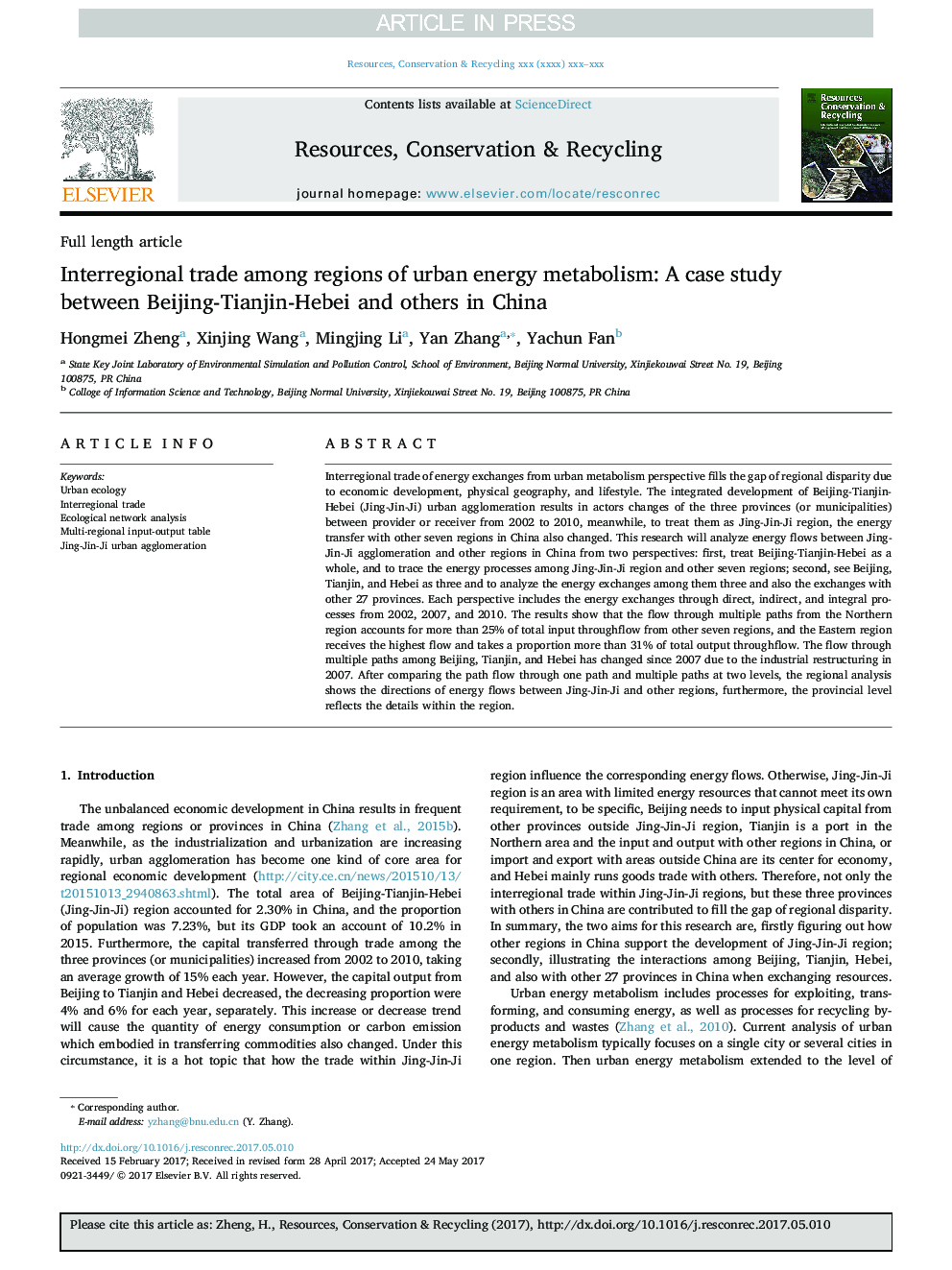| کد مقاله | کد نشریه | سال انتشار | مقاله انگلیسی | نسخه تمام متن |
|---|---|---|---|---|
| 7494428 | 1485660 | 2018 | 13 صفحه PDF | دانلود رایگان |
عنوان انگلیسی مقاله ISI
Interregional trade among regions of urban energy metabolism: A case study between Beijing-Tianjin-Hebei and others in China
ترجمه فارسی عنوان
تجارت بین منطقه ای از مناطق متابولیسم انرژی شهری: یک مطالعه موردی بین پکن-تیانجین-هبی و دیگران در چین
دانلود مقاله + سفارش ترجمه
دانلود مقاله ISI انگلیسی
رایگان برای ایرانیان
کلمات کلیدی
اکولوژی شهری، تجارت بین منطقه ای، تجزیه و تحلیل شبکه محیط زیست، جدول ورودی-خروجی چند منطقه ای، تجمع شهری جینگ جین جی،
ترجمه چکیده
تجارت بین مبادلات انرژی بین مبادلات انرژی از دیدگاه متابولیسم شهری، شکاف اختلافات منطقه ای را به دلیل توسعه اقتصادی، جغرافیای فیزیکی و شیوه زندگی پر می کند. توسعه یکپارچه از شهرک سازی شهری پکن-تیانجین-هبی (جینگ جین جی) منجر به تغییرات بازیگران سه استان (یا شهرداری ها) بین ارائه دهنده یا گیرنده از سال 2002 تا 2010 می شود، در عین حال، آنها را به عنوان جینگ جین جی منطقه، انتقال انرژی با دیگر مناطق هفت منطقه در چین نیز تغییر کرد. این تحقیق جریانهای انرژی بین شهرک سازی جینگ جین جی و دیگر مناطق چین را از دو دیدگاه بررسی می کند: اول، به طور کلی پکن-تیانجین-هبی را درمان کرده و فرآیندهای انرژی را در منطقه جینگ جین جی و دیگر هفت مناطق؛ دوم، پکن، تیانجین و هبی را سه بار ببینید و مبادلات انرژی بین آنها را سه و همچنین مبادلات با 27 استان دیگر را تجزیه و تحلیل کنید. هر چشم انداز شامل مبادلات انرژی از طریق پرونده های مستقیم، غیرمستقیم و یکپارچه از سال 2002، 2007 و 2010 می باشد. نتایج نشان می دهد که جریان از طریق مسیرهای متعدد از منطقه شمال، بیش از 25 درصد کل جریان ورودی را از دیگر مناطق هفت منطقه، و منطقه شرقی بیشترین جریان را دریافت می کند و سهم بیش از 31 درصد کل جریان خروجی را به خود اختصاص می دهد. جریان از راه های متعدد در میان پکن، تیانجین و هبی از سال 2007 به دلیل بازسازی صنعتی در سال 2007 تغییر کرده است. پس از مقایسه جریان مسیر از طریق یک مسیر و راه های متعدد در دو سطح، تجزیه و تحلیل منطقه ای نشان می دهد جهت جریان انرژی بین جینگ جین جی و دیگر مناطق، علاوه بر این، سطح ولایتی جزئیات را در منطقه نشان می دهد.
موضوعات مرتبط
مهندسی و علوم پایه
مهندسی انرژی
انرژی های تجدید پذیر، توسعه پایدار و محیط زیست
چکیده انگلیسی
Interregional trade of energy exchanges from urban metabolism perspective fills the gap of regional disparity due to economic development, physical geography, and lifestyle. The integrated development of Beijing-Tianjin-Hebei (Jing-Jin-Ji) urban agglomeration results in actors changes of the three provinces (or municipalities) between provider or receiver from 2002 to 2010, meanwhile, to treat them as Jing-Jin-Ji region, the energy transfer with other seven regions in China also changed. This research will analyze energy flows between Jing-Jin-Ji agglomeration and other regions in China from two perspectives: first, treat Beijing-Tianjin-Hebei as a whole, and to trace the energy processes among Jing-Jin-Ji region and other seven regions; second, see Beijing, Tianjin, and Hebei as three and to analyze the energy exchanges among them three and also the exchanges with other 27 provinces. Each perspective includes the energy exchanges through direct, indirect, and integral processes from 2002, 2007, and 2010. The results show that the flow through multiple paths from the Northern region accounts for more than 25% of total input throughflow from other seven regions, and the Eastern region receives the highest flow and takes a proportion more than 31% of total output throughflow. The flow through multiple paths among Beijing, Tianjin, and Hebei has changed since 2007 due to the industrial restructuring in 2007. After comparing the path flow through one path and multiple paths at two levels, the regional analysis shows the directions of energy flows between Jing-Jin-Ji and other regions, furthermore, the provincial level reflects the details within the region.
ناشر
Database: Elsevier - ScienceDirect (ساینس دایرکت)
Journal: Resources, Conservation and Recycling - Volume 132, May 2018, Pages 339-351
Journal: Resources, Conservation and Recycling - Volume 132, May 2018, Pages 339-351
نویسندگان
Hongmei Zheng, Xinjing Wang, Mingjing Li, Yan Zhang, Yachun Fan,
